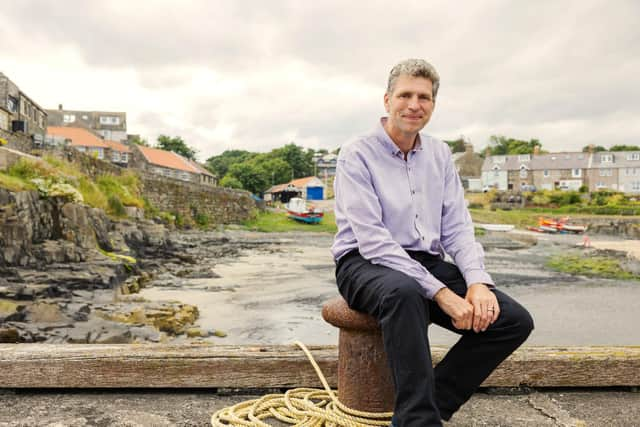Craster to feature on BBC programme Villages by the Sea
and live on Freeview channel 276
While it will be no surprise to learn that kippers play a prominent part in the programme, the village’s role in helping to pave the streets of Britain is lesser known.
Archaeologist and presenter Ben Robinson filmed the episode in July and uses clues from buildings, street patterns, artefacts and the landscape to unravel why the village is there, and how its fortunes changed over time.
Advertisement
Hide AdAdvertisement
Hide AdHe revealed: “We try to look beyond the obvious and investigate aspects of their past and the thing with Northumberland is that it's got this array of fantastically interesting places, all with their individual histories, stories and characters.


"You can look at them superficially and say 'that's a pretty place which might be a little haven and all about fishing’ but there’s this other whole story here and, for me as an archaeologist, your starting point is what you can see.
"Whenever I’ve been to Craster I’ve been intrigued by that big concrete structure on the end of the breakwater and wondered what on earth is that all about? You don’t need that for fishing or smokehouses.
"The more you look, the more you see that all across the Whin Sill and across the coast they have been hacking away at the whinstone.
Advertisement
Hide AdAdvertisement
Hide Ad"It’s an incredibly durable stone, like granite, so once they had learnt how to extract it – and until the 18th century it was difficult to work it because it’s just so hard – this was a highly sought-after material.
"Being right on the coast, Craster could ship it out in vast quantities so it attained this life as a mini industrial port.
"It’s a fantastic paving stone so you see it used like granite setts. It would have been used across the North East but it went as far as Liverpool to help build the tunnels there and part of the docks. It also went down to London to make kerb stones and setts there so it’s just incredible really.
"If you know where to look you can see traces of this once quite widespread industry but now it's almost entirely forgotten.”
Advertisement
Hide AdAdvertisement
Hide AdBen also finds out how the family and village, who both share the name Craster, have had their lives and fortunes intertwined for over 800 years.
He meets Michael Craster, who still lives in the family’s 850 year old Tower and is an expert on his ancestors. Ben follows the family tree and hears of various heads of the family such as the Georgian period’s Daniel Craster who developed quarrying in the village.
"It was a real treat meeting Michael Craster and a family which shares its name with the village,” said Ben. “The Craster we see today wouldn’t exist without that family back in history and the village we see today is not the original village.
"There was fishing there and it was a little haven but the village we see today was basically put on the coast because of the herring trade and quarrying. Previously the village was up near Craster Tower and it was moved.”
Advertisement
Hide AdAdvertisement
Hide AdBut it was possibly John Craster who gave the village its biggest legacy when he began producing kippers in the village.
Ben visits the smokehouse that is still running today, and can’t resist the urge to sample the local delicacy.
"People have known for years that if you smoke fish it preserves it but it’s when people start to do it in the right way so that it is tasty that’s the real revelation,” said Ben.
“It was almost an accident through someone’s shed burning down. It was the right kind of wood and it gave the right kind of flavour but it’s been refined over the years and people got the taste for it.
Advertisement
Hide AdAdvertisement
Hide Ad"There’s no doubt about it, Craster is justifiably famous for its kippers because they are excellent and it’s wonderful to see that heritage and food tradition surviving and thriving into the modern era and putting the place on the map.
"This is not history for history’s sake. It’s a food that’s nutritious, tasty, it’s local and it’s distinctive and Craster is as well. It’s not a museum, it’s a working and important village.”
Ben has visited the likes of Alnmouth, Bamburgh, Holy Island and Warkworth for previous programmes over the years and has developed a real love for the Northumberland coastline.
"It’s just stunning and I always love coming back,” he says.
Advertisement
Hide AdAdvertisement
Hide Ad"We saw dolphins the closest I’ve ever seen them at Craster which was great and the birdlife on the coast is fantastic.
"It’s a dramatic coastline with brilliant walks and a lovely natural environment – but when you look a little bit deeper it’s been carved and shaped and used by people and that’s the thing that really draws me to it again and again. It’s the rich heritage and stories in that part of the world that I love.
"The mistake people always make is in thinking it’s somehow remote. It isn’t. It’s in the centre of the British Isles and the trade that came down that coast from Scotland and down to Great Yarmouth – and across the North Sea to north-west Europe – meant it was very much at the centre of things back in the day.”
The Craster episode is on Friday, September 30 at 7pm on BBC Two.